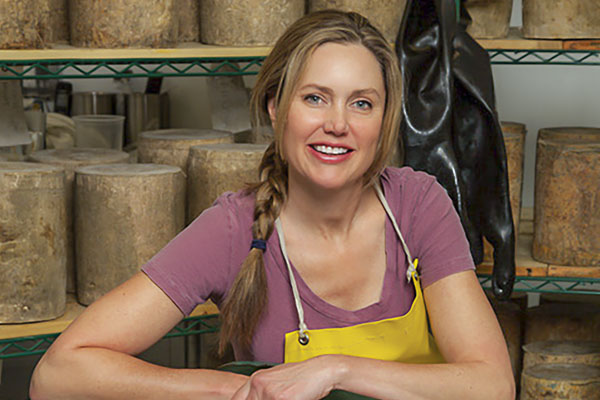I’m sad when any American cheesemaker shuts the doors, but especially someone as talented, spunky and ambitious as Wendy Mitchell. Mitchell’s ten-year-old Avalanche Cheese Company, in Colorado, won a heap of blue ribbons for its goat cheeses. Mitchell had an impressive record in business. What on earth happened?
I met Mitchell several years ago at an American Cheese Society conference. We had Dallas in common (my hometown, her college town). She told me she had pictured herself working on Wall Street after college, in a suit and heels, but instead she started a chain of burrito restaurants in Houston. Selling that successful enterprise allowed her to move to Aspen and…retire? Heck, no. She wanted to make goat cheese.
Starting with 130 acres in rural Paonia and 50 dairy goats, Mitchell quickly began making award-winning cheeses. The months she had spent interning with top British cheesemakers were paying off. She couldn’t keep up with demand for her Cabra Blanca, an aged goat tomme; Goat Cheddar; and Midnight Blue. The best cheese shops and restaurants wanted them. The farm expanded to 220 goats.
Cabra Blanca/Jim Paussa
But this past fall, Mitchell acknowledged that the venture wasn’t penciling out and was never going to. In a frank and poignant letter in the Aspen Times, she wrote about the near-impossibility of making a profit if you wanted to pay employees a living wage, treat livestock humanely and stay small. She didn’t gripe about the cost of regulations, as many cheesemakers do. And she doesn’t regret the experience. But she did tell me in a phone call that “the only negative takeaway” was a sense that the people who talk about wanting sustainable food aren’t willing to pay what it costs.
With 200 goats, a cheesemaker can produce roughly 200 pounds of cheese a day. (Depends on the cheese, but that’s ballpark.) So perhaps, during the 10 months each year that she made cheese, Mitchell grossed $3,000 a day. Deduct the cost of labor, insurance, equipment and its maintenance, vet bills, feed, utilities, packaging, transportation (milk had to be trucked from the farm to the creamery), marketing…I’m missing things but you get the picture. There’s not enough left.
Getting bigger would have helped the bottom line but at the expense of humane animal husbandry, says Mitchell. Or, she noted wryly, if she had only had more children—free labor—things might have worked.
The goats have been sold, the farm is for sale and Mitchell is concentrating on her other businesses—Meat & Cheese, a restaurant, and Hooch, a cocktail bar, both in Aspen.
Her tale left me wondering about the future of farmstead goat-cheese production in the U.S. For insights, I asked Mary Keehn of Cypress Grove, Allison Hooper of Vermont Creamery and Veronica Baetje of Baetje Farms —all leading goat-cheese makers—to comment on Mitchell’s plight and whether there’s a profitable way forward for small producers. You can read their provocative replies here.
Your Next Dinner Party?
Join me at Draeger’s Cooking School in San Mateo, CA, on Thursday, February 8, where I’ll be demonstrating the following favorite recipes. Is this your next dinner party?
- Smoked Trout Crostini
- Salad of Mixed Chicories with Fennel and Avocado
- Risotto with Lamb Ragu
- Pear Sorbet with Pear Brandy



